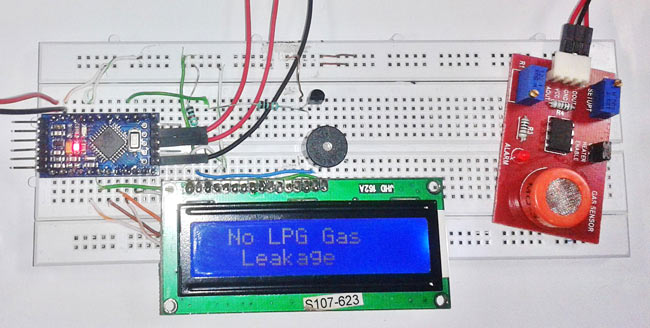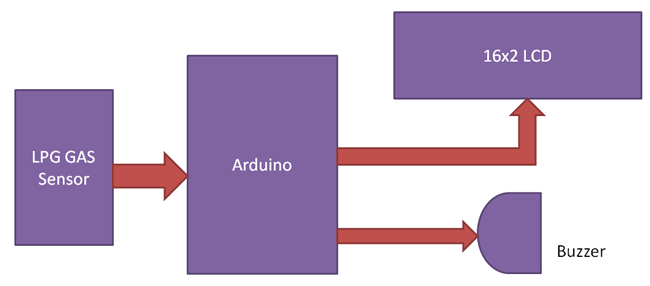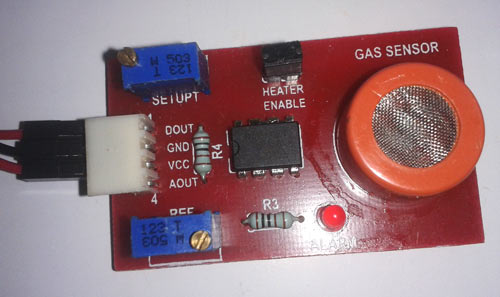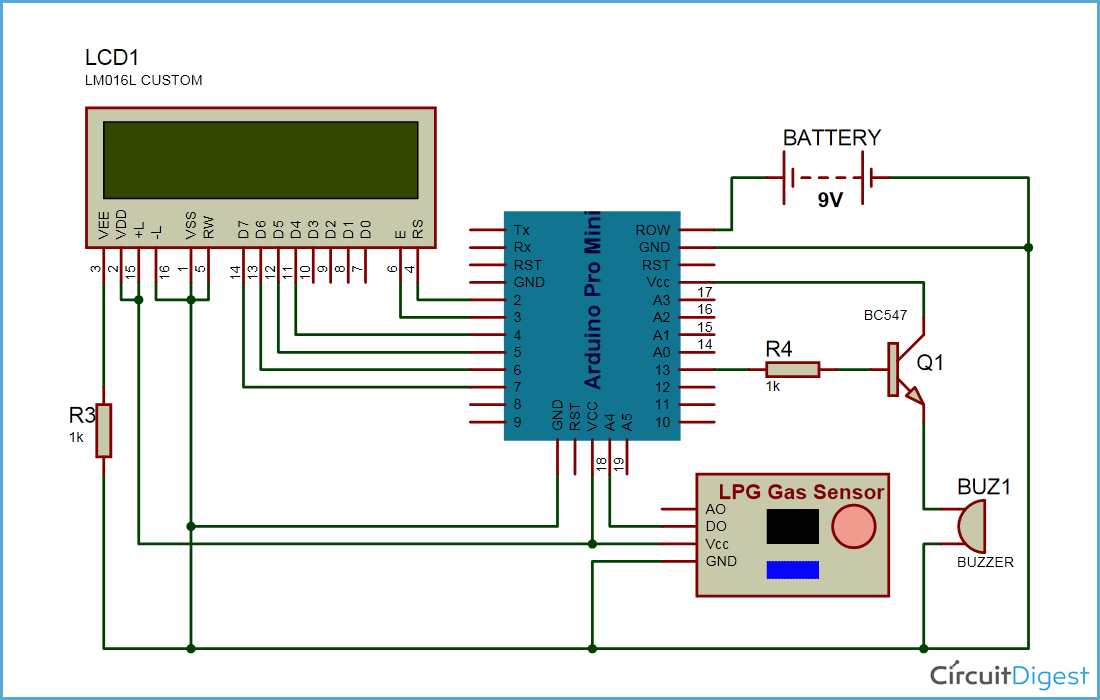
While LPG is an essential need of every household, its leakage could lead to a disaster. To alert on LPG leakage and prevent any mishappening there are various products to detect the leakage. Here we have developed an Arduino based LPG gas detector alarm. If gas leakage occurs, this system detects it and makes an alert by buzing the buzzer attached with the circuit. This system is easy to build and anyone who have some knowledge of electronics and programing, can build it..
We have used a LPG gas sensor module to detect LPG Gas. When LPG gas leakage occurs, it gives a HIGH pulse on its DO pin and arduino continuously reads its DO pin. When Arduino gets a HIGH pulse from LPG Gas module it shows “LPG Gas Leakage Alert” message on 16x2 LCD and activates buzzer which beeps again and again until the gas detector module doesn't sense the gas in environment. When LPG gas detector module gives LOW pulse to arduino, then LCD shows “No LPG Gas Leakage” message.

Components Used
- Arduino Pro Mini
- LPG Gas sensor Module
- Buzzer
- BC 547 Transistor
- 16x2 LCD
- 1K resistor
- Bread board
- 9 volt battery
- Connecting wires
LPG Gas Sensor Module
This module contains a MQ3 sensor which actually detects LPG gas, a comparator (LM393) for comparing MQ3 output voltage with reference voltage. It gives a HIGH output when LPG gas is sensed. A potentiometer is also used for controlling sensitivity of gas sensing. This module is very easy to interface with microcontrollers and arduino and easily available in market by name “LPG Gas Sensor Module”. We can also build it by using LM358 or LM393 and MQ3.

Circuit Diagram and Description
As shown in the schematic diagram above, it contains Arduino board, LPG GAS Sensor Module, buzzer and 16x2 LCD module. Arduino controls the whole process of this system like reading LPG Gas sensor module output, sending message to LCD and activating buzzer. We can set sensitivity of this sensor module by inbuilt potentiometer placed on it.
LPG gas sensor module's DO pin is directly connected to pin 18 (A4) of Arduino and Vcc and GND are connected to Vcc and GND of arduino. LPG gas sensor module consist a MQ3 sensor which detects LPG gas. This MQ3 sensor has a heater inside which needs some heater supply to heat up and it may takes up to 15 minute to get ready for detecting LPG gas. And a comparator circuit is used for converting Analog output of MQ3 in digital. A 16x2 LCD is connected with arduino in 4-bit mode. Control pin RS, RW and En are directly connected to arduino pin 2, GND and 3. And data pin D0-D7 are connected to 4, 5, 6, 7 of arduino. A buzzer is connected with arduino pin number 13 through a NPN BC547 transistor having a 1 k resistor at its base.
Program Description
In programming we have used digital read function to read output of LPG gas sensor module and then performed operation according to input.
For testing this project we have used a cigarette lighter which contains LPG gas.
#include <LiquidCrystal.h>
LiquidCrystal lcd(3, 2, 4, 5, 6, 7);
#define lpg_sensor 18
#define buzzer 13
void setup()
{
pinMode(lpg_sensor, INPUT);
pinMode(buzzer, OUTPUT);
lcd.begin(16, 2);
lcd.print("LPG Gas Detector");
lcd.setCursor(0,1);
lcd.print("Circuit Digest");
delay(2000);
}
void loop()
{
if(digitalRead(lpg_sensor))
{
digitalWrite(buzzer, HIGH);
lcd.clear();
lcd.print("LPG Gas Leakage");
lcd.setCursor(0, 1);
lcd.print(" Alert ");
delay(400);
digitalWrite(buzzer, LOW);
delay(500);
}
else
{
digitalWrite(buzzer, LOW);
lcd.clear();
lcd.print(" No LPG Gas ");
lcd.setCursor(0,1);
lcd.print(" Leakage ");
delay(1000);
}
}
Comments
I don't think there would be
I don't think there would be any problem in using arduino uno instead of pro mini to make this project. I have built an LPG detector project with Uno.
Any General purpose small NPN
Any General purpose small NPN transistor should work, like 2N2222, BC548, BC546, 2N3904, BC337 etc.
Arduino interfacing
Hello
How i can interface these Arduino with computer for programming
reagrds
You can connect Arduino with
You can connect Arduino with pc using USB cable and Arduino IDE software (Arduino Nightly : https://www.arduino.cc/en/Main/Software). Arduino NIghtly software is used to write, verify and upload the code to arduino, through PC.
Why does my circuit switch
Why does my circuit switch off automatically when i connect the vcc of sensor to the vcc of arduino ? Pls help
what do you mean by "circuit
what do you mean by "circuit switch off"? Please be specific and check the circuit connections twice.
program detailed meaning
plz i request you to kindly tell me detailed meaning of this program. :)
Program is easy and self
Program is easy and self explanatory, just go through our other basic projects and check some beginners tutorials on internet.
Thanks
My sensor doesnt light up if
My sensor doesnt light up if i connect my arduino's vcc to its vcc. But my lcd screen lights up perfectly. Pls help.
My lcd screen shows only
My lcd screen shows only black boxes. What should i do ?
I got the same problem,when
I got the same problem,when my sensor detected a gas,..my buzzer buzzing but my LCD shows only black boxes. What should i do ?
I think you did anything
I think you did anything wrong in connection.
Please make sure the lcd pins.
In code we have selected lcd(3,2,4,5,6,7);
look at this
RS pin Connected at pin 3 and EN at 2.
may be your problem will resolved.
best of luck.
When my sensor detect gas,my buzzer is ON but my LCD goes blank.
When my sensor detect gas,my buzzer is ON but my LCD goes blank. What should i do ?
I think you did anything
I think you did anything wrong in connection.
Please make sure the lcd pins.
In code we have selected lcd(3,2,4,5,6,7);
look at this
RS pin Connected at pin 3 and EN at 2.
may be your problem will resolved.
best of luck.
Educational
Job well done. Is it possible I get a video of the design process?, and also can you tell me where I can get these components in case they are not available in my area here?.
Good Job, but be careful
I commend the creator for this wonderful project but one should be wary of using hobbyist grade electronics for Gas/Flammable applications. The problem is what if a gas leak would be ignited by such device. I would rather advise buying IS rated equipment from certified vendors. Btw, I work for one such vendor but any vendor will do as long as they are certified in delivering IS devices.
Congrats for a job well done!
IT31 Computer Interfacing
can i use Arduino Uno instead of Arduino Mini ? Please help thank you :)
Can you give me the complete
Can you give me the complete and specific materials needed for this project?
Required materials/components
Required materials/components are already given in the article.
ELECTRONICS
kindly guide me how can i get LPG sensor frm proteus library?? asap
about gas lighter and gas sensor module
can i use mq-2 or mq-6 instead of mq-3 module? will all lighters contain LPG gas?
for problem of sparking
the ardunio may be sparking of cold enviorment and conducter liquid interaction in inegrated circuit. but i will not know about whats voltage and current power and frequency in sparking in combination in positive and negative terminal.i will try of 5v and .6 A CURRENT IN IC.AND I WANT know that the limit o f minimum and maximum of power voltage and current.
can u provide connections
can u provide connections using arduino uno ! plzz ?
LPG_GAS Project
i want to test the project .pls send to me complete code .There is no main functions in that code. i want extend few modules also. could u help me pls
plzzz can u send me the
plzzz can u send me the circuit diagram using arduino uno plzzz :!!
How about coupling and making
How about coupling and making it look more attractive?...how can that be done
program problem
This type of error at uploading the program on broad pls replay fast
"Arduino: 1.8.2 Hourly Build 2017/01/17 12:35 (Windows 10), Board: "Arduino/Genuino Uno"
Sketch uses 2302 bytes (7%) of program storage space. Maximum is 32256 bytes.
Global variables use 133 bytes (6%) of dynamic memory, leaving 1915 bytes for local variables. Maximum is 2048 bytes.
avrdude: ser_open(): can't open device "\\.\COM1": The system cannot find the file specified.
Problem uploading to board. See http://www.arduino.cc/en/Guide/Troubleshooting#upload for suggestions.
This report would have more information with
"Show verbose output during compilation"
option enabled in File -> Preferences.
lpg gas leakage derector
Hi, sir
when i am supply the arduino uno then after the buzzer and display are show the gas was leakage but that time no gas leakage when i am apply the gas then the both buzzer and display was no gas leakage how to solve the problem
plz Sir reply fast
NO DISPLAY ON LCD
i am not getting any display on lcd. only the backlight lights up. all connections are proper. DO i have to use a potentiometer????
Yes you should use
Yes you should use potentiometer to control the brightness of the LCD, sometimes brightness is too high that text might not be visible.
Regarding gas sensor module
I am mot getting the exact lpg gas sensor module..Can anyone provide me the link from where i can get this ??
lpg gas detecto using arduino
how to upload the code into arduino pro mini
Can i use arduino nano
Can i use arduino nano instead? and if yes will there be any changes in connections?
Should i use alphanumeric
Should i use alphanumeric display or ordinary lcd display?
How to i trip mcb while gas
How to i trip mcb while gas leackage using arduino ?
sir how can i make msg alert
sir how can i make msg alert in this project
I just wanna know that if I
I just wanna know that if I am making a project of LPG gas detection circuit and want to house my compact circuitry on the regulator of LPG gas cylinder then which type of battery will be safer to use. Because as we know that it will be quite dangerous to use batteries like li-po and li-ion etc. near such kind of dangerous gases. So kindly suggest me regarding my sorting the batteries problem.
Power it from AC main sorce
Using battery for such application is not recommended. Most of the Gas alarms are powered from AC mains directly. This way you can esure that they are active all the time.
May be you can use a battery to back-up in the even of power failure. In those cases a Li-po is normally used. Yes they are dangerous, but only if you design a bad circuit. Li-po has good energy density hence mostly used in portable electronics. You can use a coin cell for back up and they tend to be more safe







I'm confused. When I look it up on the arduino site, it says that the MQ2 sensor is sensitive to LGP but here you used the MQ3 sensor. can you explain why?